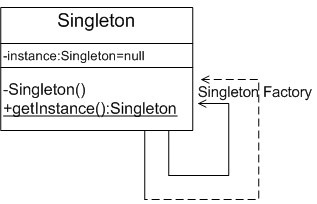目的
只有一個實例,而且自行實例化並向整個系統提供這個實例。
Ensure a class only has one instance, and provide a global point of access to it.
適用
當整個系統只需要、或必須只允許只有一個該類別物件存在時使用。
結構及成員
Collaborations: 該類別本身。

影響結果
好處
實作
方法
- 依情況,可以實作為積極單例(Eaget)、懶散單例(Lazy)、或懶散雙重鎖單例(Double Lazy)等等。
Example:
Eager Singleton
public class EagerSingleton {
private static EagerSingleton instance = new EagerSingleton();
private EagerSingleton() {}
public static EagerSingleton getInstance() {
return instance;
}
}Lazy Singleton
public class LazySingleton {
private static LazySingleton instance;
private LazySingleton() {}
public static LazySingleton getInstance() {
if (instance == null) instance = new LazySingleton();
return instance;
}
}Lazy Double Singleton
public class LazyDoubleSingleton {
private static LazyDoubleSingleton instance;
private LazyDoubleSingleton() {}
public static LazyDoubleSingleton getInstance() {
if (instance == null) {
synchronized(LazyDoubleSingleton.class) {
if (instance == null) instance = new LazyDoubleSingleton();
}
}
return instance;
}
}
